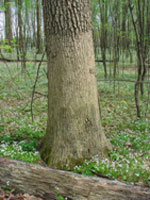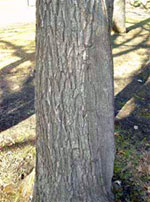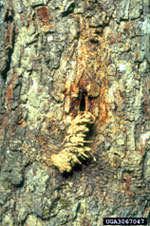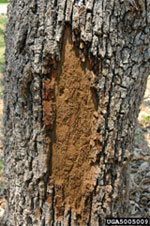Tree Notes
by Gretchen Riley, Texas Forest Service
Reprinted by permission of Cross Timbers Urban Forestry Council
Oh No! Bark Is Piling Up at the Base of My Tree!




Don’t panic! There are several reasons bark can be sloughing off and piling at the base of a tree and not all of them are fatal.
Sloughing or peeling of the bark can be a normal process, especially in the spring when the tree increases growth. Bark may peel or fall off the tree in sheets, plates, strips or blocks depending on species.
Smooth patch (top photo) is a disease typically caused by the fungus Aleurodiscus oakesii. The fungus breaks down the dead bark of an oak tree and uses it as a food source, causing the bark to fall off. Smooth patch may cause the oak to appear unsightly, but it is not a threat to the tree’s overall health.
Sunscald and frost cracks (second photo from top) can also cause splitting and sloughing of bark. Both sunscald and frost cracks are localized bark injuries that often occur on the southwest side of younger trees, and normally heal on their own. Usually not fatal themselves, sunscald and frost cracks can allow the entry of bacterial pathogens or insects which may cause harm to the tree.
Sometimes, sloughing of bark is cause for concern. Extensive infestations of borers can cause sloughing of bark (third photo from top) and result in death of young or newly transplanted trees. Typically evidence of borer infestation is observed as sawdust found beneath exit holes in the trunk and large branches, or sawdust-filled tunnels beneath the bark. Damage often manifests as sparse and yellowing foliage.
Hypoxylon canker, caused by the opportunistic fungi Hypoxylon atropuntatum, also results in sloughing of bark in infected trees (bottom photo). Tan, olive green, or reddish-brown powdery spores can be seen where the bark has sloughed off and the bark chips are found at the base of the tree. Hypoxylon is quick to colonize weakened or damaged wood and is often more prevalent during drought. Typically, by the time the symptoms are apparent, it is too late for the tree.
About the author: Gretchen Riley, staff forester for Texas Forest Service, provides statewide coordination and assistance for various urban forestry programs. She holds a master’s in forestry from Texas A&M University and has been an ISA Certified Arborist for over 10 years.
Thank you to the Cross Timbers Urban Forestry Council for permission to use this article, which appeared in the January 2012 edition of the organization’s e-newsletter, Tree Notes. Find more information at http://www.ctufc.org/.

